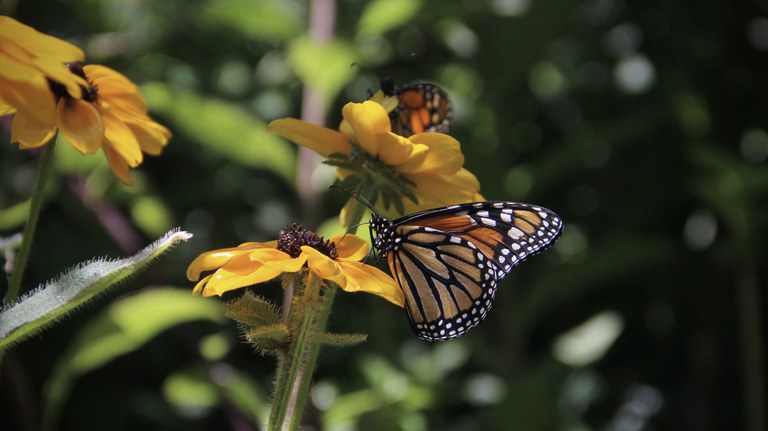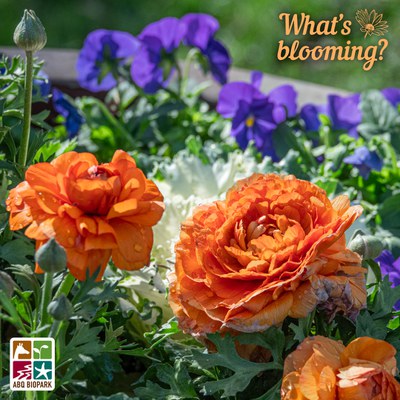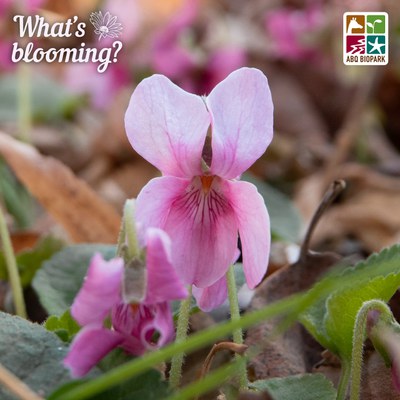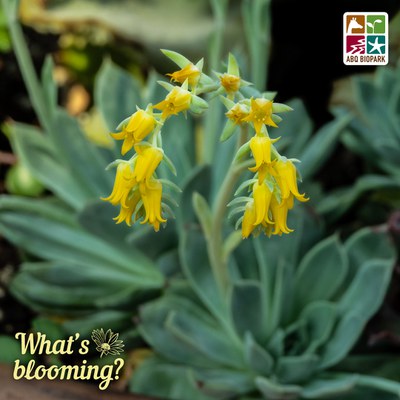Botanic Garden

Opened in 1996, the Botanic Garden has grown to 32 acres of exhibits, and showcases plants from the American Southwest and around the world.
The Botanic Garden’s BUGarium is one of the most elaborate exhibits dedicated to bugs and arthropods in the country.
The Travel Channel cites ABQ BioPark Botanic Garden as one of the top 12 in the country!
Seasonal Update:
Learn more about featured seasonal plants!
Featured on 4/2/25: The Botanic Garden has welcomed spring with seasonal arrangements located throughout the garden! Look for these classy and colorful containers featuring striking hues of purple, orange or yellow, and white. Herbaceous perennial Viola ‘Penny Blue” makes a beautiful border at around 4-6 inches tall, with a compact habit and subtle fragrance. Standing tall in the middle of the containers at 12-24 inches are the multi-colored ranunculus, cultivars from the genus Ranunculus which contains about 1750 species. The large, thin-petaled flowers resemble roses with their dense layers and are sure to catch your eye, especially when contrasted against the bright white of the ornamental cabbage ‘Osaka Wavy White’. It may not be the first thing many think of, but a bright rosette of frilly white leaves makes ornamental cultivars from the genus Brassica a great choice for a beautiful ground cover that adds dimension and compliments other blooms. Ornamental cabbages can be 12 inches wide and 6 inches tall, so plan your space accordingly when arranging your own borders or containers and look for varieties in other shades as well, including pinks, purples, and reds.
These cool-weather annuals work together perfectly in the spring when the nights are still cool, and can even withstand a light freeze when our New Mexico weather waffles in the transition of the seasons. Full sun to partial shade will yield the best flowering season, ranunculus may not flower at all in full shade. Containers may need more frequent watering than in the ground, but wherever you choose make sure you have good drainage and keep them moist but not soaked. These arrangements will be on display through the beginning of May when summer color will take over, so head in for a spring stroll at the Botanic Garden and check them out!

Featured on 3/26/25: Roses are red, violets are blue; but did you know? They come in pink, too! The sweet, distinctive fragrance is recognized in the species name Viola odorata, with odorata meaning “fragrant” or “perfumed” in Latin. This flowering herbaceous perennial, found around the edges of forests or clearings in parts of Eurasia, is not only popular for its strong scent: both the flowers and leaves are edible and have long been enjoyed fresh, candied, in a syrup, and even in marshmallows! Common names include wood violet, sweet violet, common violet, or March violet for their spring flowering season. V. odorata makes a beautiful, low ground cover in shady areas, leaving a blanket of dark green heart-shaped leaves that are semi-evergreen even after the flowering season.
Violets need a sheltered spot in your garden with dappled sun or shade, and can grow in a variety of fertile soils, as long as they are well-drained. The soil can be allowed to be visibly dry between watering, and then thoroughly saturate them. They can be used in beds, borders, underplanting shrubs and roses, and in containers or pots. They can self-spread by runners at a moderate rate, but can be pruned in late fall. Removing spent flowers may also extend the flowering season, but as the nights warm up above 40º they will go dormant. Whether you choose traditional blues and purples or a variation in pink or white, violets can bring beautiful color and an attractive aroma to your gardens!

Featured on 3/12/25: There’s hardly a better choice for a low maintenance and water-conscious plant in New Mexico than the many species of cactus and succulents. Echeveria is a large genus of flowering succulents, including nearly 200 species and a wide variety of award-winning hybrids, which are native to Central America, Mexico, and northwestern South America in semi-desert habitats. Some species play a vital role as host plants to butterfly species that rely on them for reproduction. Although the foliage of their compact rosettes are evergreen, the flowering season is typically spring and summer when they sprout arching stalks with small, vibrant bell or star-shaped flowers that may be red, orange, yellow, or white which can last for several weeks. Though they will sometimes produce offsets at the base, they are typically slow-growing and stay low to the ground.
Tolerance of drought and full sun are part of what makes species and hybrids of Echeveria a popular ornamental choice for even the most casual gardeners, though they are not frost-hardy and should be brought inside for protection against freezing winters. Some species may also need protection from the hottest sun exposure here, so if you have any doubt about which species or cultivar you have the best bet is an east or southeast-facing light exposure. For the ease of relocation according to temperatures, they are best potted in plants whether you keep yours indoors or outdoors. Water Echeveria and other succulents when the soil is dry, which may be weekly depending on factors such as the container size, sun exposure and heating your home in winter, and how many plants are sharing the same pot. They can benefit from fertilizer and a cactus & succulent soil mix, but should have good drainage. You can also check the plant’s needs by gently feeling the bottom leaves: firm leaves means no additional water is needed, whereas softer leaves are thirsty. Succulents provide an easy, but beautiful, southwestern aesthetic to any space!

Featured on 3/5/25: Species, hybrids, and cultivars in the genus Helleborus are also among the first to awaken in late winter or early spring, though some even open pure white flowers in deep winter, earning the common name Christmas rose. Some other common names for the 22 species of Helleborus include winter rose and Lenten rose, though these members of the buttercup family Ranunculaceae are not closely related to true roses of Rosaceae. Species originated in woodlands or rocky slopes in Europe and Asia, with the greatest concentration of native species in the Balkans. The popular garden species, H. orientalis, is native to Greece and Turkey. The flowers of hellebores are actually five sepals, although their shape and color patterns are similar in appearance to petals. Through hybridising, mostly between H. orientalis and closely related species, the color range of the flowers can include near-black, slate gray, deep purples and plums, rich reds and pinks, green, yellow, and white. Some plants are also now double flowered. With a long flowering season around eight to ten weeks, these unique perennial blooms will greet you early and stick around through spring or until the heat here in Albuquerque begins to rise.
Hellebores grow in clumps in partial to full shade, and with their evergreen foliage they can be a great choice to fill in covered empty spaces year-round. It's considered easy to grow in darker areas with protection from high winds in moist, but well-drained, soil with a pH that is neutral to alkaline. As with all early bloomers, pollinators will appreciate the food source. One word of caution: hellebores are poisonous to humans, dogs, cats, and horses, and can also irritate the skin when handling so gloves are recommended. But the good news? Deer and other passing animals generally leave them alone! Find the look that appeals to you and add this striking beauty to your border, patio, woodland garden, cottage garden, under trees or shrubs, or even in containers, and enjoy a long-lasting burst of color.

No results were found.
